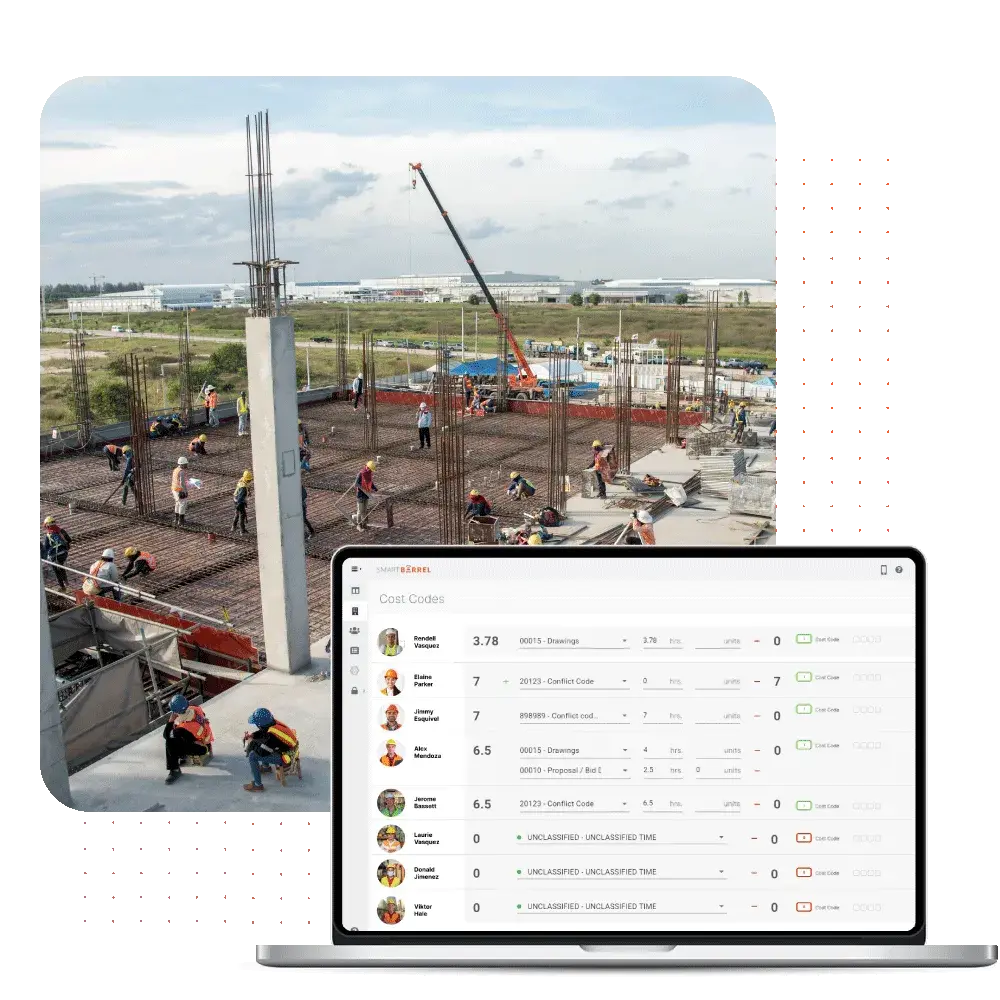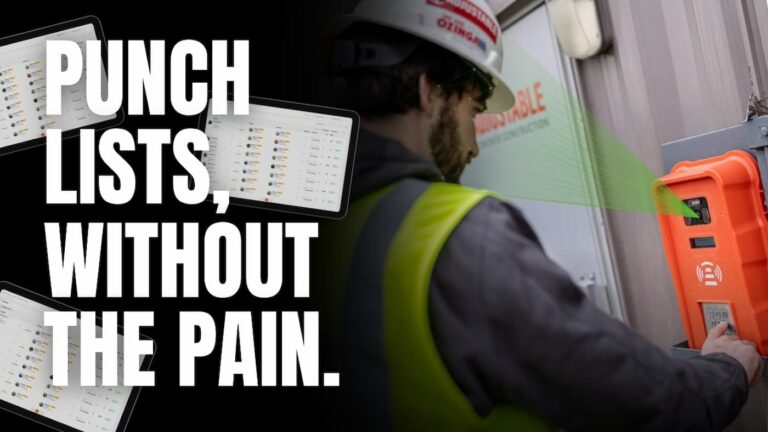Overhead costs are silently draining your profits. Each untracked work hour, misplaced material order, or payroll error quickly accumulates. The worst thing is that most contractors have no idea how much money they are losing until it’s too late.
Untracked labor hours? Excessive administrative expenses? Poor job costing? These aren’t just minor issues. They are major problems that are stealing your profits. Approximately 10–15% of purchased construction materials are recorded as waste, contributing significantly to project cost overruns and reduced profitability. That’s money slipping through these cracks.
If you don’t really know your construction overhead that well, then you are only guessing and not taking charge of your profits. Controlling these costs is not just about maintaining expenses, but it is about protecting your profitability. Using automated time tracking allows you to improve job costing and gives you real-time visibility into labor costs.
This guide breaks down overhead construction costs, how to properly calculate them, and how precise time tracking can lead to saving unnecessary costs. You can then prevent losing money and control your earnings.
What is Overhead in Construction?
Overhead costs are the ongoing indirect expenses required to keep your business running. Overhead costs in construction include things like office rent, administrative salaries, insurance, and utilities—costs that support your operations but aren’t directly tied to any one project. General overhead costs in the construction industry represent a huge portion of any project. If you ignore overhead costs, you are guessing at your profits, and that’s a gamble no contractor can afford.
Understanding Construction Overhead Costs
Overhead accounts for many expenses. Here are three types of costs that you will need to calculate for overhead:
- Administrative labor: Salaries and benefits for office staff not assigned to specific projects.
- Facilities and utilities: Office rent, utilities, and insurance.
- General business expenses: Marketing, office supplies, and company-wide software or tools.

Types of Overhead Costs in Construction
There are two types of costs in construction: direct costs and overhead (indirect costs). Direct costs are tied to specific projects, such as labor, materials, and equipment rentals. Overhead refers to indirect expenses that support business operations but aren’t linked to a single project.
Overhead Costs
Now that you have learned about direct costs, let’s take a look at overhead costs. Overhead costs are not linked to just one project and can easily be missed or forgotten. These costs include salaries for office staff, office supplies, marketing costs, vehicle expenses, equipment purchases, uniforms, cell phones, office parties, storage rent, and tool allowances. These are some common indirect construction overhead costs.
What is Profit in Construction?
Profit in the construction industry refers to the income a company generates after accounting for its overhead and direct expenses. Companies assess their profits when completing construction projects. This allows them to evaluate their total earnings based on the final costs of the project.
In comparison to overhead, which shows the outflow of cash from a business, profits represent the revenue that is kept by companies after they have covered overhead and other costs. Depending on the nature of the work undertaken by a company, profit calculations might incorporate additional deductions specific to individual projects.
To determine the total profits, you have to use this formula:
Profit = ( Project cost ) – (overhead + direct costs).

Get Control of Your Time Tracking
How To Calculate Overhead Costs in Construction Projects
To calculate overhead costs in the construction industry effectively, follow the below steps:
Step 1: Identify All Overhead Costs
Overhead costs are all indirect by nature, though some may be project-specific (like jobsite trailers or temporary security). These are still considered overhead because they’re not tied to physical production like labor or materials. Indirect overhead expenses are those that support more than one project. Gather all these expenses over a given time period, like a month or year, for an overall view of overhead.
Step 2: Choose an Allocation Basis
Next, determine how overhead expenses will be assigned to every project. The method should reflect the utilization of resources. Here are some common choices to include:
- Labor Hours: Assigned using total hours worked on each project.
- Labor Costs: Utilize total wages that are paid per project.
- Direct Costs: Allocate a percentage of direct costs.
- Square Footage: Divide overhead by the project size in square feet.
- Machine Hours: Allocated based on the number of machine hours utilized per project.
Select the option most appropriate for your business operations.
Step 3: Calculate Total Overhead Costs
Add all the overhead expenses from Step 1 for your chosen period. This total shows your company’s overall overhead burden. For example:
Office rent: $2,000/month
Administrative salaries: $6,000/month
Insurance premiums: $2,000/month
Utilities: $1,000/month
Total Overhead Costs = $11,000/month.
Step 4: Determine the Total Allocation Base
Count the total amount from your chosen allocation basis across all projects for the same period. For example, if using labor hours:
Project 1: 500 hours
Project 2: 300 hours
Project 3: 200 hours
Total Labor Hours = 1,000 hours.
Step 5: Calculate the Overhead Rate
The overhead rate is the total overhead costs divided by the total allocation base. This rate tells you how much overhead cost is associated with each unit of your chosen base. Here is the formula:
Overhead Rate = Total Overhead Costs / Total Allocation Base.
Step 6: Apply the Overhead Rate to Projects
To allocate overhead to individual projects, multiply the overhead rate by the project’s portion of the allocation base. Here is an example using direct costs:
If a construction project had estimated costs of $50,000 and the overhead rate is 47%:
Allocated Overhead $50,000 × 0.47 = $23,500
(Note: Overhead rates vary widely depending on business type and should be calculated from your own financials.)
Step 7: Regularly Update Calculations
Overhead costs can change due to a number of factors, such as new hires or changes in insurance premiums. Regular updates keep your project accurate.
Step 8: Monitor and Adjust
Keep track of how overhead allocations affect the overall profitability. If your construction overhead percentage seems too high, then look for ways to cut expenses or improve efficiency, such as using time-tracking software, automating tasks, or negotiating a better lease rate.
Additional Methods for Allocating Overhead
Different allocation methods may suit different types of construction businesses:
Method | Best For | Example Calculation |
Labor Hours | Labor-intensive projects | Divide total overhead by total labor hours; allocate based on hours worked per job. |
Direct Costs | Projects with high material or subcontractor use | Divide total overhead by total direct costs; allocate as a percentage per project. |
Square Footage | Building/renovation projects | Divide total overhead by total square footage; allocate based on project size. |
Machine Hours | Machine-intensive operations | Divide total overhead by machine hours; allocate based on usage per project. |
Get Control of Your Time Tracking
Challenges of Managing Construction Overhead
Managing construction overhead is a challenging job, but it is manageable when you know the pitfalls. Here is what you need to watch out for:
- Hidden Costs: Overhead expenses often lurk in the shadows. Small administrative mistakes lead to wasted time, and time translates to money lost.
- Overhead Allocation: Distributing overhead across projects is a complex task, especially when costs overlap between job sites. Keep it simple and track it closely.
- Market Changes: Fluctuating fuel prices and supply shortages can suddenly spike your overhead. Stay ahead of these changes with proactive budgeting.
- Project Delays: Delays from weather or poor management don’t just stall your project, they inflate your overhead. Indirect costs such as rent and insurance keep accumulating regardless of progress.
It’s time to take control. Simplify your processes, increase visibility, and implement systems that keep overhead in check. Time-tracking is your best buddy for reducing overhead. It is not just a suggestion but a necessity.
The Role of Time Tracking in Reducing Construction Overhead
Time theft is costing you dollars. Forgetting to clock in and clocking in for one another all drive up labor costs and lead to payroll errors. Eliminate these losses by incorporating effective time-tracking solutions.
Using our advanced time-tracking solutions, you can view real-time insights into proper labor data. It means you clearly understand exactly how many working hours every staff member spends at the job, and you can budget appropriately, thanks to the proper allocation of costs. No more assumptions; make better business decisions supported by facts.
Real-time visibility into labor usage enables you to reallocate as needed. Maximize your workforce to maintain projects on schedule, avoid delays, and facilitate smooth operations. Automated time-tracking also reduces administrative headaches. With fewer payroll mistakes, your back-office staff can concentrate on key tasks instead of spending hours reconciling timesheets.
Investing in SmartBarrel gives you the visibility and control you need over your labor resources. Streamlining your time-tracking processes allows you to increase efficiency and save costs. Don’t let time theft erode your profits; take control now.
Importance of Time Tracking in Construction
Time-tracking in construction is important for more than just paying workers. It helps with budgeting, compliance, project costs, and overall profits. If time-tracking is inaccurate, it can lead to hidden costs such as:
- If hours are wrongly recorded, then the company may pay employees for time they didn’t work.
- Mistakes in time-tracking can cause delays in knowing how much work has been completed.
- Without correct time data, job costing can be unreliable, which results in errors in budgeting, forecasting, and profit assessments.
Without accurate time-tracking, construction businesses can struggle to manage labor costs effectively, which can directly affect their profit margins.
Features of Effective Time Tracking Tools for Overhead Management
Not all time-tracking applications are created equally. To effectively control construction overhead, look for tools that possess the following features:
- Biometric Verification: The feature ensures that employees are not faking clock-ins by verifying their identities.
- Geofencing Capabilities: These capabilities make sure that workers are at the job site when they clock in or out.
- Real-Time Reporting: This feature allows real-time visibility into labor use and expense.
- Payroll Integration: This automates payroll by syncing timesheets with payroll applications.
- Durability for Job Sites: This includes weatherproof devices that can handle touch construction conditions.
These features help time-tracking tools reduce errors and lower overhead costs.
Benefits of Minimizing Construction Overhead Through Time Tracking
Reducing the overhead cost in construction using effective time-tracking offers several benefits, such as:
- Lowering unnecessary expenses improves overall profitability.
- Better cost data improves future project bids.
- Automated time-tracking removes human data entry errors.
- Accurate records help meet labor laws and contractual obligations.
Get Control of Your Time Tracking
Tired of Time Theft Eating your Profits? Choose SmartBarrel
Time theft and payroll disputes are costing you real money. SmartBarrel eliminates these issues with AI-powered facial verification and geofencing, ensuring you pay only for the actual working hours.
Other systems fail when conditions get challenging. SmartBarrel’s equipment holds up and provides you with real-time labor insights. Reclaim control over your labor costs, reduce administrative burdens, and improve your project bids with SmartBarrel.
Final Thoughts
Construction overhead is silently eating into your profits. Untracked labor hours, inefficient payroll processes, and poor cost visibility add up fast. If you don’t have a reliable system in place, then you could be losing money without even realizing it.
Without real time-tracking, overhead costs are difficult to control. SmartBarrel helps eliminate inefficiencies by automating time-tracking, allowing you to know daily clock-ins, and giving you complete visibility into labor time management. By streamlining these processes, you can cut waste, improve job costing, and boost your bottom line.
Take control of your labor costs today. Request a Demo and see how SmartBarrel can help you reduce unnecessary overhead and maximize profitability.




